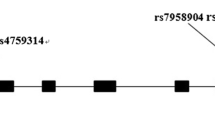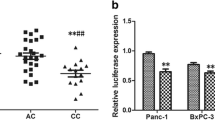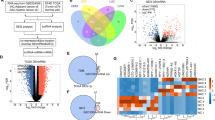Abstract
Tens of thousands of long non-coding RNAs (lncRNAs) have been identified through RNA-seq analysis, but the biological and pathological significance remains unclear. By integrating the genome-wide lncRNA data with a cross-ancestry meta-analysis of PDAC GWASs, we depicted a comprehensive atlas of pancreatic ductal adenocarcinoma (PDAC)-associated lncRNAs, containing 1,204 lncRNA (445 novel lncRNAs and 759 GENCODE annotated lncRNAs) and 4,368 variants. Furthermore, we found that PDAC-associated lncRNAs could function by altering chromatin activity, transcription factors, and RNA-binding proteins binding affinity. Importantly, genetic variants linked to PDAC are preferentially found at PDAC-associated lncRNA regions, supporting the biological and clinical relevance of PDAC-associated lncRNAs. Finally, we prioritized a novel transcript (MICT00000110172.1) of RP11-638I2.4 as a potential tumor promoter. MICT00000110172.1 is able to reinforce the interaction with YY1, which could reverse the effect of YY1 on pancreatic cancer cell cycle arrest to promote the pancreatic cancer growth. G > A change at rs2757535 in the second exon of MICT00000110172.1 induces a spatial structural change and creates a target region for YY1 binding, which enforces the effect of MICT00000110172.1 in an allele-specific manner, and thus confers susceptibility to tumorigenesis. In summary, our results extend the repertoire of PDAC-associated lncRNAs that could act as a starting point for future functional explorations, and the identification of lncRNA‐based target therapy.





Similar content being viewed by others
Data availability
The datasets generated during the current study are available from the corresponding author on reasonable request. Informed consent was obtained from each subject, and this study was approved by the Chinese Academy of Medical Sciences Cancer Institute and the Institutional Review Board of Tongji Medical College, HUST. All participants gave written informed consent.
References
Bertani S, Sauer S, Bolotin E, Sauer F (2011) The noncoding RNA Mistral activates Hoxa6 and Hoxa7 expression and stem cell differentiation by recruiting MLL1 to chromatin. Mol Cell 43(6):1040–1046. https://doi.org/10.1016/j.molcel.2011.08.019
Chen Q, Yang C, Chen L et al (2019a) YY1 targets tubulin polymerisation-promoting protein to inhibit migration, invasion and angiogenesis in pancreatic cancer via p38/MAPK and PI3K/AKT pathways. Br J Cancer 121(11):912–921. https://doi.org/10.1038/s41416-019-0604-5
Chen Q, Zhang JJ, Ge WL et al (2019b) YY1 inhibits the migration and invasion of pancreatic ductal adenocarcinoma by downregulating the FER/STAT3/MMP2 signaling pathway. Cancer Lett 463:37–49. https://doi.org/10.1016/j.canlet.2019.07.019
Chen Q, Shen P, Ge WL et al (2021) Roundabout homolog 1 inhibits proliferation via the YY1-ROBO1-CCNA2-CDK2 axis in human pancreatic cancer. Oncogene 40(15):2772–2784. https://doi.org/10.1038/s41388-021-01741-5
Consortium EP (2012) An integrated encyclopedia of DNA elements in the human genome. Nature 489(7414):57–74. https://doi.org/10.1038/nature11247
Das S, Forer L, Schonherr S et al (2016) Next-generation genotype imputation service and methods. Nat Genet 48(10):1284–1287. https://doi.org/10.1038/ng.3656
Derrien T, Johnson R, Bussotti G et al (2012) The GENCODE v7 catalog of human long noncoding RNAs: analysis of their gene structure, evolution, and expression. Genome Res 22(9):1775–1789. https://doi.org/10.1101/gr.132159.111
Dimitrakopoulos C, Vrugt B, Flury R et al (2019) Identification and validation of a biomarker signature in patients with resectable pancreatic cancer via genome-wide screening for functional genetic variants. JAMA Surg 154(6):e190484. https://doi.org/10.1001/jamasurg.2019.0484
Dykes IM, Emanueli C (2017) Transcriptional and post-transcriptional gene regulation by long non-coding RNA. Geno Prot Bioinform 15(3):177–186. https://doi.org/10.1016/j.gpb.2016.12.005
Ge WL, Chen Q, Meng LD et al (2020) The YY1/miR-548t-5p/CXCL11 signaling axis regulates cell proliferation and metastasis in human pancreatic cancer. Cell Death Dis 11(4):294. https://doi.org/10.1038/s41419-020-2475-3
Genomes Project, Abecasis GR, Auton A et al (2012) An integrated map of genetic variation from 1,092 human genomes. Nature 491(7422):56–65. https://doi.org/10.1038/nature11632
Gibb EA, Brown CJ, Lam WL (2011) The functional role of long non-coding RNA in human carcinomas. Mol Cancer 10:38. https://doi.org/10.1186/1476-4598-10-38
Guo Y, He J, Zhao S et al (2014) Illumina human exome genotyping array clustering and quality control. Nat Protoc 9(11):2643–2662. https://doi.org/10.1038/nprot.2014.174
Hon CC, Ramilowski JA, Harshbarger J et al (2017) An atlas of human long non-coding RNAs with accurate 5’ ends. Nature 543(7644):199–204. https://doi.org/10.1038/nature21374
Huang W, Loganantharaj R, Schroeder B, Fargo D, Li L (2013) PAVIS: a tool for Peak annotation and visualization. Bioinformatics 29(23):3097–3099. https://doi.org/10.1093/bioinformatics/btt520
Iyer MK, Niknafs YS, Malik R et al (2015) The landscape of long noncoding RNAs in the human transcriptome. Nat Genet 47(3):199–208. https://doi.org/10.1038/ng.3192
Liu D, Zhang J, Wu Y et al (2018) YY1 suppresses proliferation and migration of pancreatic ductal adenocarcinoma by regulating the CDKN3/MdM2/P53/P21 signaling pathway. Int J Cancer 142(7):1392–1404. https://doi.org/10.1002/ijc.31173
Loh PR, Danecek P, Palamara PF et al (2016) Reference-based phasing using the Haplotype Reference Consortium panel. Nat Genet 48(11):1443–1448. https://doi.org/10.1038/ng.3679
Mizrahi JD, Surana R, Valle JW, Shroff RT (2020) Pancreatic cancer. Lancet 395(10242):2008–2020. https://doi.org/10.1016/S0140-6736(20)30974-0
Perez-Ortin JE, Alepuz P, Chavez S, Choder M (2013) Eukaryotic mRNA decay: methodologies, pathways, and links to other stages of gene expression. J Mol Biol 425(20):3750–3775. https://doi.org/10.1016/j.jmb.2013.02.029
Petersen GM, Amundadottir L, Fuchs CS et al (2010) A genome-wide association study identifies pancreatic cancer susceptibility loci on chromosomes 13q221, 1q321 and 5p1533. Nat Genet 42(3):224–228. https://doi.org/10.1038/ng.522
Purcell S, Neale B, Todd-Brown K et al (2007) PLINK: a tool set for whole-genome association and population-based linkage analyses. Am J Hum Genet 81(3):559–575. https://doi.org/10.1086/519795
Qian X, Zhao J, Yeung PY, Zhang QC, Kwok CK (2019) Revealing lncRNA Structures and Interactions by Sequencing-Based Approaches. Trends Biochem Sci 44(1):33–52. https://doi.org/10.1016/j.tibs.2018.09.012
Slack FJ, Chinnaiyan AM (2019) The role of Non-coding RNAs in oncology. Cell 179(5):1033–1055. https://doi.org/10.1016/j.cell.2019.10.017
Uszczynska-Ratajczak B, Lagarde J, Frankish A, Guigo R, Johnson R (2018) Towards a complete map of the human long non-coding RNA transcriptome. Nat Rev Genet 19(9):535–548. https://doi.org/10.1038/s41576-018-0017-y
Wang KC, Yang YW, Liu B et al (2011) A long noncoding RNA maintains active chromatin to coordinate homeotic gene expression. Nature 472(7341):120–124. https://doi.org/10.1038/nature09819
Wang C, Li Y, Yan S et al (2020) Interactome analysis reveals that lncRNA HULC promotes aerobic glycolysis through LDHA and PKM2. Nat Commun 11(1):3162. https://doi.org/10.1038/s41467-020-16966-3
Wang H, Li J, Wang S et al (2021) Contribution of structural accessibility to the cooperative relationship of TF-lncRNA in myopia. Brief Bioinform. https://doi.org/10.1093/bib/bbab082
Washietl S, Kellis M, Garber M (2014) Evolutionary dynamics and tissue specificity of human long noncoding RNAs in six mammals. Genome Res 24(4):616–628. https://doi.org/10.1101/gr.165035.113
Wong CH, Lou UK, Fung FK et al (2022) CircRTN4 promotes pancreatic cancer progression through a novel CircRNA-miRNA-lncRNA pathway and stabilizing epithelial-mesenchymal transition protein. Mol Cancer 21(1):10. https://doi.org/10.1186/s12943-021-01481-w
Wu C, Miao X, Huang L et al (2011) Genome-wide association study identifies five loci associated with susceptibility to pancreatic cancer in Chinese populations. Nat Genet 44(1):62–66. https://doi.org/10.1038/ng.1020
Xu F, Huang M, Chen Q et al (2021) LncRNA HIF1A-as1 promotes gemcitabine resistance of pancreatic cancer by enhancing glycolysis through modulating the AKT/YB1/HIF1alpha pathway. Cancer Res 81(22):5678–5691. https://doi.org/10.1158/0008-5472.CAN-21-0281
Zhang JJ, Zhu Y, Xie KL et al (2014) Yin Yang-1 suppresses invasion and metastasis of pancreatic ductal adenocarcinoma by downregulating MMP10 in a MUC4/ErbB2/p38/MEF2C-dependent mechanism. Mol Cancer 13:130. https://doi.org/10.1186/1476-4598-13-130
Zhang JJ, Zhu Y, Zhang XF et al (2017) Yin Yang-1 suppresses pancreatic ductal adenocarcinoma cell proliferation and tumor growth by regulating SOX2OT-SOX2 axis. Cancer Lett 408:144–154. https://doi.org/10.1016/j.canlet.2017.08.032
Zheng J, Huang X, Tan W et al (2016) Pancreatic cancer risk variant in LINC00673 creates a miR-1231 binding site and interferes with PTPN11 degradation. Nat Genet 48(7):747–757. https://doi.org/10.1038/ng.3568
Zhou C, Yi C, Yi Y et al (2020) LncRNA PVT1 promotes gemcitabine resistance of pancreatic cancer via activating Wnt/beta-catenin and autophagy pathway through modulating the miR-619-5p/Pygo2 and miR-619-5p/ATG14 axes. Mol Cancer 19(1):118. https://doi.org/10.1186/s12943-020-01237-y
Acknowledgements
We are grateful to all members in Miao lab who participated in the study, as well as all individuals who helped us successfully complete the research. Besides, all procedures involving human participants were in accordance with the ethical standards laid down in the 1964 Declaration of Helsinki and its later amendments. This work was supported by Distinguished Young Scholars of China (NSFC-81925032), Key Program of National Natural Science Foundation of China (NSFC-82130098) for Xiaoping Miao; the Fundamental Research Funds for the Central Universities (2042022rc0026, 2042023kf1005) for Xiaoping Miao; Youth Program of National Natural Science Foundation of China (NSFC-82003547), Program of Health Commission of Hubei Province (WJ2023M045) and Fundamental Research Funds for the Central Universities (WHU: 2042022kf1031) for Ying Zhu.
Author information
Authors and Affiliations
Contributions
MZ conducted experiments and wrote the paper. MZ and YL conducted the statistical analyses and interpreted the results. FZ, HG, YC downloaded the data and conducted the data preprocessing. ZL, BL, CN, WW, and HL were responsible for investigation and sample collection. HL, ZL, BL recruited patients. JT and YZ conceived the study. XM supervised the whole project.
Corresponding authors
Ethics declarations
Conflict of interest
The authors declare no conflict of interest.
Additional information
Publisher's Note
Springer Nature remains neutral with regard to jurisdictional claims in published maps and institutional affiliations.
Supplementary Information
Below is the link to the electronic supplementary material.
Rights and permissions
Springer Nature or its licensor (e.g. a society or other partner) holds exclusive rights to this article under a publishing agreement with the author(s) or other rightsholder(s); author self-archiving of the accepted manuscript version of this article is solely governed by the terms of such publishing agreement and applicable law.
About this article
Cite this article
Zhang, M., Li, Y., Zhang, F. et al. Risk SNP in a transcript of RP11-638I2.4 increases lncRNA–YY1 interaction and pancreatic cancer susceptibility. Arch Toxicol 97, 2799–2812 (2023). https://doi.org/10.1007/s00204-023-03564-7
Received:
Accepted:
Published:
Issue Date:
DOI: https://doi.org/10.1007/s00204-023-03564-7




